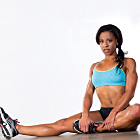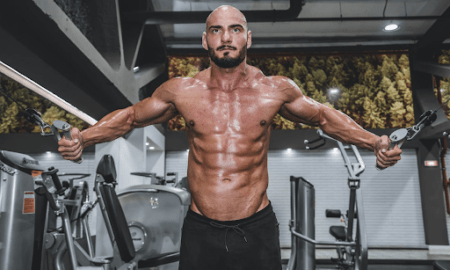 Q: A few issues ago you urged readers to stretch, “but only if it’s done safely.” How do you recommend that we stretch?
Q: A few issues ago you urged readers to stretch, “but only if it’s done safely.” How do you recommend that we stretch?
A: As I noted in that column, although stretching isn’t essential, it is strongly recommended, provided you do it safely.
A flexible body is an important asset for bodybuilding; without sufficient flexibility you won’t be able to exploit fully two of the most effective exercises, the squat and the deadlift. If, for example, your hamstrings are tight, you won’t be able to use correct squatting technique because it will lead to premature rounding of your lower back.
Flexible muscles are also required for youthfulness regardless of age. Movements in general become restricted if you don’t have a supple body. There’s reduced resilience, or give, in the body to withstand sudden movements safely. Dynamic balance is impaired, and the loose connective tissue loses its lubricating properties. (Loose connective tissue fills the spaces between muscle and nervous and epithelial tissue and between bone and cartilage, tendons and ligaments and joints and joint capsules.)
As a result, muscles lose some of their elasticity and ability to function smoothly, and tendons, ligaments and joint capsules become brittle. Tissues in general become more susceptible to injury, and the body ages at an accelerated rate.
As you can now see, the benefits of having a supple body are extensive and not just for bodybuilding.
To become flexible in the first place, stretch three times a week, on nonconsecutive days. (Once you’re supple enough, you can maintain it with just twice-weekly stretching.) An ideal time to stretch is immediately after a weight workout, when you’re fully warmed up. If you stretch at another time, first do some easy general activity that breaks you into a sweat. And always stretch in a warm room.
Immediately prior to squatting or deadlifting, you may need to do some gentle stretching of your calves, hamstrings, adductors and glutes—just enough to ensure that you’re at your normal level of flexibility.
Stretching is dangerous if done incorrectly. If you try to rush your progress, you’ll get hurt. Never force a stretch. Work progressively, within a given workout and from week to week, until you reach the level of flexibility that you’ll maintain. Never bounce while stretching—and avoid holding your breath; just breathe normally.
Don’t try to move immediately into your usual level of flexibility for a given stretch. Work into it over several progressive stretches, each one taking you a little farther than the previous one. You should feel only slight discomfort as you stretch.
Do a minimum of three reps of 20 to 45 seconds for each stretch. Be cautious—do more rather than fewer progressive stretches before getting to your current limit stretch.
As you hold each rep of a stretch, you should feel the muscular tension diminish. Depending on the stretch, and the individual, you may need to hold a stretch for up to 45 seconds—and perhaps even longer—before you feel this slackening. The easing of tension is the signal to relax for a few seconds, then move farther into the stretch in order to make the muscle(s) feel tight again. If you don’t feel the tension diminishing even after a hold of 45 to 60 seconds, let the stretch go for a few seconds, then slowly move into the next rep.
Never force yourself to feel pain, but you must feel tension during each stretch. Never have anyone force you into a stretch. And never be in a hurry.
On some days you’ll be less flexible than others, so don’t expect to stretch equally well at every session.
Stretching is a pleasure, when done properly. Enjoy it!
Some stretches are performed on the floor. Be careful how you get up from lying on your back, or you may irritate your lower back. Don’t sit up with straight knees. While on your back, bend your knees and, with your knees held above your chest, briskly roll off your back into a sitting position. As an alternative, roll to one side and, using your hands for assistance, push into a sitting position.
You may find that muscles on one limb—or on one side of your torso—are less flexible than those on the opposite side. If so, perform additional reps of each relevant stretch on the less-flexible side in a one-sided stretch; or place greater emphasis on the less flexible side in a two-sided stretch. Be patient and persistent. Over time this should yield symmetrical left-right flexibility unless there are muscle restrictions that require treatment by an expert in soft-tissue therapy.
If you know that you’re tight in a certain muscle or muscles, and no matter how persistent you are with stretching you can’t increase your flexibility there, you probably have some muscle restrictions in that area. Unless you get them released—try a soft-tissue therapist—you may never increase your flexibility there. Stretching alone won’t do it.
Apply the above guidelines to a set of stretches that work your overall body. For special application to bodybuilding—to ensure that your exercise technique isn’t hampered by inflexibility—you must cover these areas: calves, hamstrings, quads, groin muscles and thigh adductors, buttocks, hip flexors (the muscles over the front of your pelvis), shoulder and chest tie-ins and obliques (the muscles at the sides of your midsection).
Don’t think of the stretching as a burden on your time. It’s an investment. When done properly, it’s an injury-proofing, health-promoting and enjoyable supplement to your training program.
—Stuart McRobert
www.Hardgainer.com
Editor’s note: Stuart McRobert’s first byline in IRON MAN appeared in 1981. He’s the author of the new BRAWN series, Book 1: How to Build Up to 50 Pounds of Muscle the Natural Way, available from Home Gym Warehouse (800) 447-0008 or www.Home-Gym.com.




















You must be logged in to post a comment Login